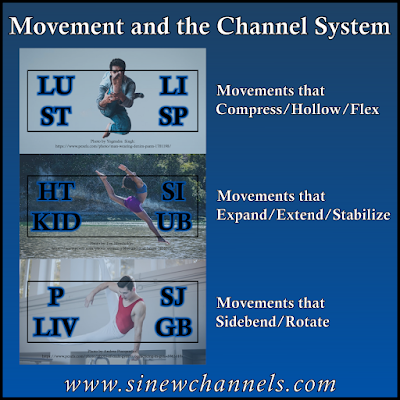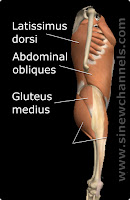The Acupuncture Channels Organize Movement
The image above describes 3 groupings of acupuncture channels (sometimes referred to as meridians). These channels in each grouping are all related and anyone who studies Chinese and East Asian medicine, including things like acupuncture, tuina, qigong and herbal medicine, would see and understand something about these groupings.
The major functional movement patterns are organized by these 3 groupings and you do not need to have studied Chinese medicine to understand this. I can use a bunch of technical jargon such as describing the 3 networks by the names in the graphic above, but I can make it far simpler by describing the basic movement patterns that these channel parings do. These three groupings produce the following three movement patterns. They:
1) Expand, extend, and propel the body forward,
2) Compress, flex, and hollow the body; and they
3) Side bend and rotate the body.
Expansive movements which propel the body forward:
We can look at something relatively simple such as a pull up for an example of this movement pattern. This movement engages muscles of the back of the torso and shoulder girdle. And, if your form is good, there is engagement of core. This relatively straightforward movement primarily involves expansive movements that lift and propel the body forward. These movements lift the body up (literally, in the image below), but also lift you into an upright posture when standing and walking; and they also stabilize the spine.
.jpg) |
| Photo by Ruslan Khmelevsky: https://www.pexels.com/photo/muscular-sportsman-doing-pull-up-exercise-in-gym-4608157/ |
Compressive movements which hollow the body:
Other movement patterns compress and hollow the body. They protract the scapulae, depress the chest, and flex the torso and hip. There are many calisthenic and gymnastic exercises which illustrate this movement pattern. Hollow body holds, L-sits, a front kick, and many other movements fall into this category. The image below shows a gymnastics moves called a planche which is being performed on gymnastics rings. These movements protract the scapulae (round the shoulder girdle), depress the chest, and they flex the torso and hip. 
Photo by Andrea Piacquadio:
https://www.pexels.com/photo/photo-of-male-gymnast-practicing-on-gymnastic-rings-3763702/
These movements also balance the expansive ones described above and there are many exercises that move back and forth between these two groupings. For instance, rowers would move back and forth between these phases; going into a compression so that they have more range as they engage the back, expand and propel forward as they pull the paddle through the water. You have to compress and load the spring before you expand, especially if you want to do it explosively. The spinal wave from White Crane qigong is another example of this ebb and flow and you can watch my video by clicking here.
 |
| Photo by Andrea Piacquadio: https://www.pexels.com/photo/photo-of-male-gymnast-practicing-on-gymnastic-rings-3763702/ |
These movements also balance the expansive ones described above and there are many exercises that move back and forth between these two groupings. For instance, rowers would move back and forth between these phases; going into a compression so that they have more range as they engage the back, expand and propel forward as they pull the paddle through the water. You have to compress and load the spring before you expand, especially if you want to do it explosively. The spinal wave from White Crane qigong is another example of this ebb and flow and you can watch my video by clicking here.
Movements which side bend and rotate the body:
Sidebending and rotation are two separate movements....., sort of. Major joints of the spine and pelvis couple these two movements which means that if you perform one of these movements, you are doing the other. Some movements are more apparently side bending, while others are more about rotation, but from a kinesiology standpoint, these movements are very integrated together and not as easily separated.
These movements involves trunk and neck side bending, but also abduction and adduction of the limbs, along with rotational movements. To fully understand this category, you also need to understand that this movement pattern involves preventing too much movement by stabilizing the sides of the body. It involves the muscles which allow us to stand on one leg, even momentarily such as when we are walking or running, without the hip buckling and failing to support this weight. Walking or running is actually a great example of this patterns since the rotation of this hips and spine is so integral to healthy gait.
Another very simple example is in a video below where I am swinging on monkey bars. This exercise emphasizes rotation, but you will also see side bending if you watch the video.
 |
| Photo by Los Muertos Crew: https://www.pexels.com/photo/woman-doing-sports-at-sports-hall-10039561/ |














